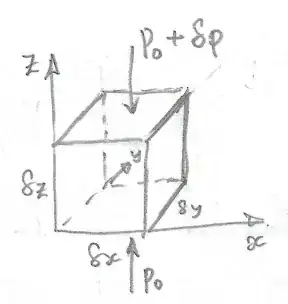Suppose that we consider an element of fluid, density $\rho$, of sides $\delta x,\,\delta y$ and $\delta z$ as shown in the diagram below.

The arrows adjacent to pressure labels, $P_0$ and $P_0+\delta P$, indicate the directions of the forces on the element which have magnitudes, $P_0\,\delta x\,\delta y$ and $(P_0+\delta P)\,\delta x\,\delta y$ due to the pressure at $z$ and $z+\delta z$ respectively.
If the element is assumed to be in equilibrium the net force on it must be zero,
ie $P_0\,\delta x\,\delta y - (P_0+\delta P)\,\delta x\,\delta y-\delta x \,\delta y\,\delta z \,\rho\,g=0 \Rightarrow \dfrac {\delta P}{\delta z} = - \rho \,g$
and if $\delta z \to 0$ then $\dfrac {dP}{dz} = - \rho \,g$ which is called the hydrostatic equation.
I imagine that you were considering a point, which has no dimensions, in the fluid, where you could say that the pressure was $P_0$ and there was also a rate of change of pressure with respect to height, $z$.
